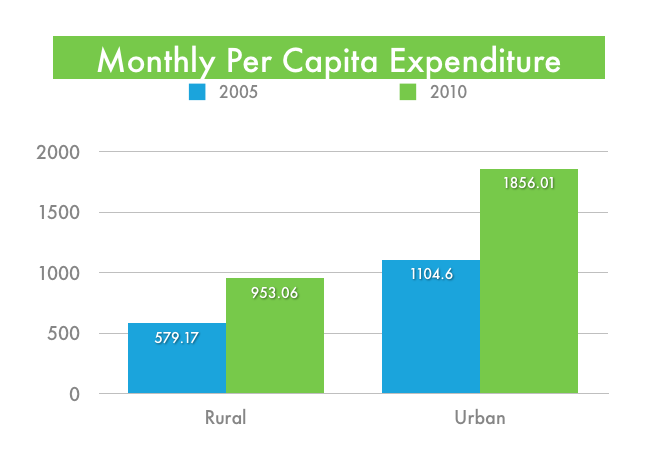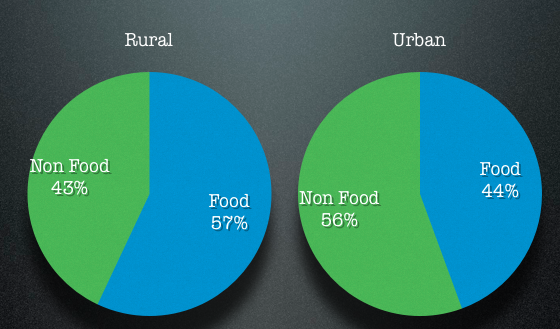The National Sample Survey Office (NSSO) surveys households in rural and urban areas every 5 years, and calculates the household monthly per capita expenditure (MCSE) for rural and urban households.
This gives an indication on where people are spending their money, and is meant to provide inputs in policy formulation for fighting poverty. For example, a relatively poor family will spend more on food as a percentage of their income than a richer one, and these kind of inputs can help in decision making.
There are three categories in the survey:
- Clothing, bedding, footwear, education, medical, durable goods.
- Edible oil, egg, fish and meat, vegetables, fruits, spices, beverages and processed foods; pan, tobacco and intoxicants
- All other food, fuel, and light, miscellaneous goods and services including non – institutional medical; rents and taxes.
When I read these categories I thought that the maximum spend will be on the third category because a lot of people live in rented houses which is a major expense for many people; even fuel, travel etc. will come in that category which again forms a big chunk of most people’s expenses. However, the results didn’t show this.
Let’s look at what the survey showed, which was done for the period of July 2009 – June 2010.
At a national level, both the rural and urban areas showed growth in their monthly per capita expenditure, but the Urban per capita expense is almost twice the rural one. This can be clearly seen in the table below.

This is probably not a surprise to anyone since you have seen several examples of the rural – urban divide, and this only works to reinforce what we already know.
The next thing to look at is how much do people spend on food in rural versus urban areas.

You can see that there is quite a significant difference between how much money people have to spend on food in rural and urban areas.
So, we have a situation where 74% of our population is in the rural areas as we saw in the unemployment numbers post, and that large workforce is mainly employed in agriculture; though the share of agriculture in total economic activity is just 19%, and even while they are primarily engaged in agriculture, they have to spend a proportionately higher sum of their income on food!
I don’t know if anyone has a magic bullet to improve this situation, but I believe that when the government eventually allows FDI in multi brand retail and allows large foreign players to set shop in India – some of this will be corrected. There is a lot of food wastage today, and it’s because of an ineffective Public Distribution System (PDS) as well as insufficient infrastructure, too many middle men, farmers not getting their fair share etc.
A lot of investment in infrastructure can only be done if you allow foreign players to come in, and I think it’s only a matter of time when they are allowed to come in, and the consequent heavy investment will improve this situation.

I was apalled to see tons of wheat stored openly with just a plastic sheet to cover them. Tons of mangoes, tomatoes etc especially perishable agri products get wasted due to poor storage and lack of distribution. High time we had big players in this sector.
Yes, it is sad to think that prices are so high as to make food unaffordable to a lot of people at one hand, and such a lot of it rots on the other.
I couldn’t agree anymore on wastage of food. Apart from that, sadly huge quantities of wheat and other food grains get spolied due to poor storage, rain etc.
Poor storage and infrastructure is a real problem, and probably the only way to solve that is to get some foreign investment going in that sector. I’m a bit surprised this is taking so long as there are international companies in virtually every other area from cars to washing machines to clothes, and at the same time Indian companies are competing well with them. That these foreign companies create so many jobs and employment is also evident.
This survey is bogus and does not make any sense to me.How can you club Pan, Tobacco and Intoxicants with food items?What is all other food and why has it been put in category 3?How much a person spends on food does not depend on whether a person lives in rural area or urban area.It only depends on how much a person earns.You don’t need a survey to tell you that with so high food inflation, people with low incomes have to spend a proportionately higher amount of their income on food items than comparatively well to do people.
You need data to see how things are progressing, and compare one period with another. If anything, I’d want this survey to be done every 6 months instead of 5 years. If you don’t get data how do you know that policies are working or not? Now with Mr. Ramesh becoming the Minister of Rural Development, you would expect some fireworks there, but how do you know if things really improve if you don’t look at the data?
I understand that there is a lot of skepticism about Indian data whether it be on unemployment, IIP or frequent revisions to inflation, but I don’t think any of our data is fake or bogus.
It may not be totally accurate due to deficiencies in methodology or data gathering but I won’t go as far as to say it is fake.